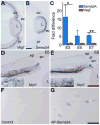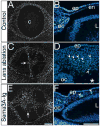Sema3A maintains corneal avascularity during development by inhibiting Vegf induced angioblast migration
- PMID: 24809797
- PMCID: PMC4103428
- DOI: 10.1016/j.ydbio.2014.04.017
Sema3A maintains corneal avascularity during development by inhibiting Vegf induced angioblast migration
Abstract
Corneal avascularity is important for optical clarity and normal vision. However, the molecular mechanisms that prevent angioblast migration and vascularization of the developing cornea are not clear. Previously we showed that periocular angioblasts and forming ocular blood vessels avoid the presumptive cornea despite dynamic ingression of neural crest cells. In the current study, we investigate the role of Semaphorin3A (Sema3A), a cell guidance chemorepellent, on angioblast migration and corneal avascularity during development. We show that Sema3A, Vegf, and Nrp1 are expressed in the anterior eye during cornea development. Sema3A mRNA transcripts are expressed at significantly higher levels than Vegf in the lens that is positioned adjacent to the presumptive cornea. Blockade of Sema3A signaling via lens removal or injection of a synthetic Sema3A inhibitor causes ectopic migration of angioblasts into the cornea and results in its subsequent vascularization. In addition, using bead implantation, we demonstrate that exogenous Sema3A protein inhibits Vegf-induced vascularization of the cornea. In agreement with these findings, loss of Sema/Nrp1 signaling in Nrp1(Sema-) mutant mice results in ectopic angioblasts and vascularization of the embryonic mouse corneas. Altogether, our results reveal Sema3A signaling as an important cue during the establishment of corneal avascularity in both chick and mouse embryos. Our study introduces cornea development as a new model for studying the mechanisms involved in vascular patterning during embryogenesis and it also provides new insights into therapeutic potential for Sema3A in neovascular diseases.
Keywords: Angioblast; Cornea; Eye development; Nrp1; Sema3A; Vasculogenesis; Vegf.
Copyright © 2014 Elsevier Inc. All rights reserved.
Figures






Similar articles
-
PlexinD1 is required for proper patterning of the periocular vascular network and for the establishment of corneal avascularity during avian ocular development.Dev Biol. 2016 Mar 1;411(1):128-39. doi: 10.1016/j.ydbio.2016.01.001. Epub 2016 Jan 16. Dev Biol. 2016. PMID: 26783882 Free PMC article.
-
Expression of pro- and anti-angiogenic factors during the formation of the periocular vasculature and development of the avian cornea.Dev Dyn. 2013 Jun;242(6):738-51. doi: 10.1002/dvdy.23956. Epub 2013 Apr 24. Dev Dyn. 2013. PMID: 23444323 Free PMC article.
-
Cell survival controlled by lens-derived Sema3A-Nrp1 is vital on caffeine-suppressed corneal innervation during chick organogenesis.J Cell Physiol. 2019 Jun;234(6):9826-9838. doi: 10.1002/jcp.27671. Epub 2018 Oct 26. J Cell Physiol. 2019. PMID: 30362583
-
The role of FGF and VEGF in angioblast induction and migration during vascular development.Dev Dyn. 2001 Jan;220(1):1-17. doi: 10.1002/1097-0177(2000)9999:9999<::AID-DVDY1087>3.0.CO;2-2. Dev Dyn. 2001. PMID: 11146503 Review.
-
Neuropilin regulation of angiogenesis, arteriogenesis, and vascular permeability.Microcirculation. 2014 May;21(4):315-23. doi: 10.1111/micc.12124. Microcirculation. 2014. PMID: 24521511 Free PMC article. Review.
Cited by
-
Primary cilia deficiency in neural crest cells models anterior segment dysgenesis in mouse.Elife. 2019 Dec 17;8:e52423. doi: 10.7554/eLife.52423. Elife. 2019. PMID: 31845891 Free PMC article.
-
In vivo topology converts competition for cell-matrix adhesion into directional migration.Nat Commun. 2019 Apr 3;10(1):1518. doi: 10.1038/s41467-019-09548-5. Nat Commun. 2019. PMID: 30944331 Free PMC article.
-
Alterations in Corneal Sensory Nerves During Homeostasis, Aging, and After Injury in Mice Lacking the Heparan Sulfate Proteoglycan Syndecan-1.Invest Ophthalmol Vis Sci. 2017 Oct 1;58(12):4959-4975. doi: 10.1167/iovs.17-21531. Invest Ophthalmol Vis Sci. 2017. PMID: 28973369 Free PMC article.
-
Wnt Signaling in vascular eye diseases.Prog Retin Eye Res. 2019 May;70:110-133. doi: 10.1016/j.preteyeres.2018.11.008. Epub 2018 Dec 1. Prog Retin Eye Res. 2019. PMID: 30513356 Free PMC article. Review.
-
It Takes Two to Tango: Coupling of Angiogenesis and Osteogenesis for Bone Regeneration.Front Bioeng Biotechnol. 2017 Nov 3;5:68. doi: 10.3389/fbioe.2017.00068. eCollection 2017. Front Bioeng Biotechnol. 2017. PMID: 29164110 Free PMC article. Review.
References
-
- Abramoff MD, Magalhães PJ, Ram SJ. Image processing with ImageJ. Biophotonics Int. 2004;11:36–42.
-
- Amano S, Rohan R, Kuroki M, Tolentino M, Adamis AP. Requirement for vascular endothelial growth factor in wound- and inflammation-related corneal neovascularization. Invest Ophthalmol Vis Sci. 1998;39:18–22. - PubMed
-
- Ash J, Overbeek P. Lens-specific VEGF-A expression induces angioblast migration and proliferation and stimulates angiogenic remodeling. Dev Biol. 2000;223:383–398. - PubMed
-
- Bagri A, Tessier-Lavigne M, Watts RJ. Neuropilins in tumor biology. Clin Cancer Res Off J Am Assoc Cancer Res. 2009;15:1860–1864. - PubMed
Publication types
MeSH terms
Substances
Grants and funding
LinkOut - more resources
Full Text Sources
Other Literature Sources
Molecular Biology Databases
Miscellaneous

